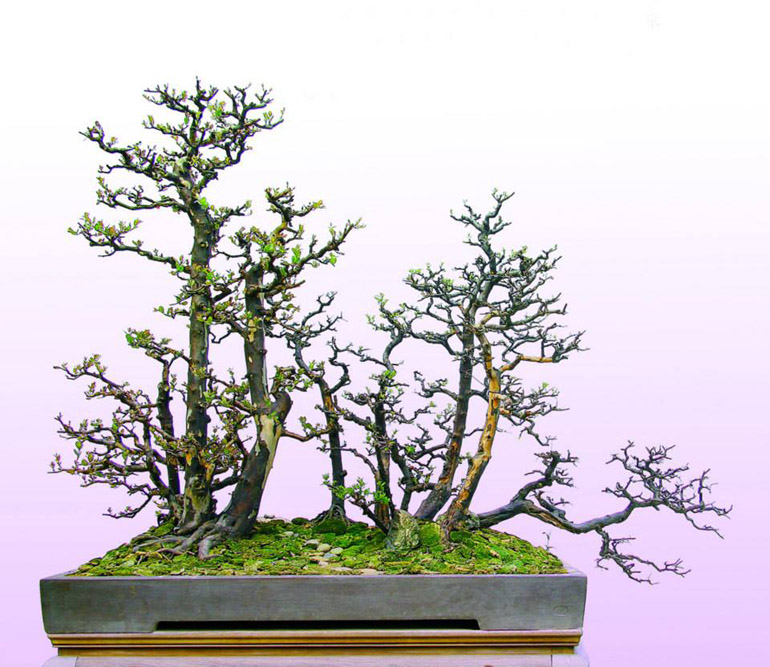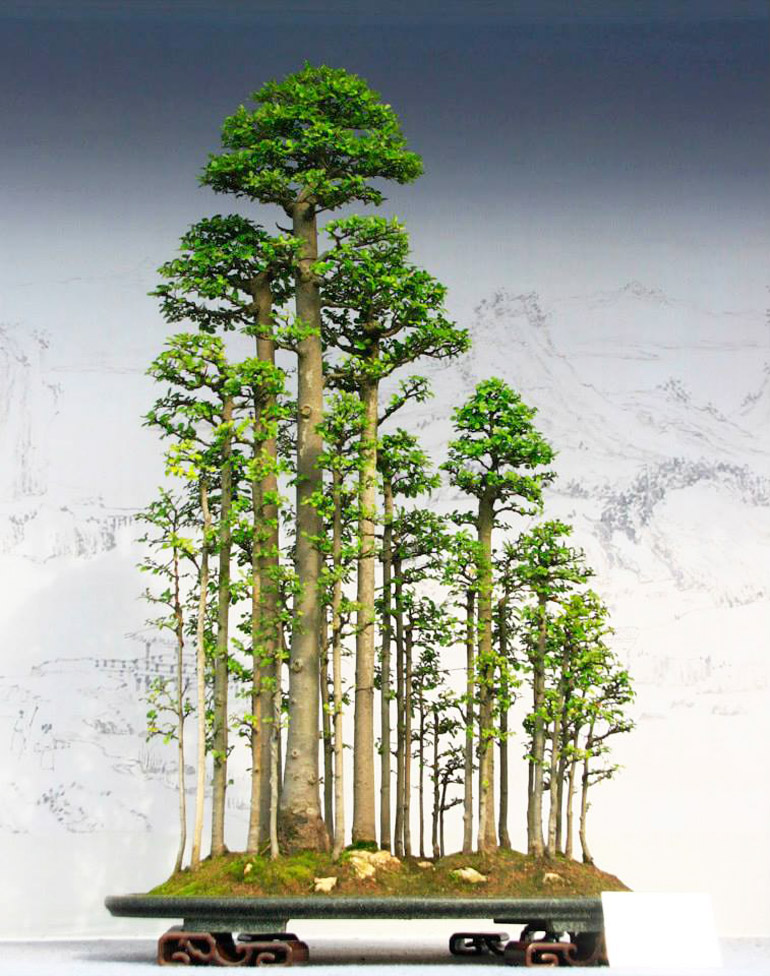How many trunk does this spectacular Trident maple (Acer buergerianum) grove have? It's from an award winning display at the 2013 Taikan Bonsai Exhibition. The artist is Kenji Oshima. The photo is from Bill Valavanis Bonsai blog.
The odd rule. Almost anyone who plays with bonsai for a while will incorporate the odd number of trees rule into their storehouse of bonsai wisdom. It goes something like this: In any group planting (with more than two trunks), you should use an odd number of trees. This applies at least up to eleven trunks. After eleven, it doesn’t matter because who can count that high (something like that).
Once you realize that this, or any other bonsai rule, is simply a guideline that may or may not be useful depending upon the situation, than you are free to experiment. I usually avoid 4s and 6s because that’s the way I learned (mostly from paying attention to Japanese bonsai artists, many of whom make strong arguments for asymmetrical compositions and feel that odd numbers are important in achieving this), but I don’t feel bound to odd numbers.
Enough from me, let’s hear from Robert Steven, a serious bonsai scholar and famous bonsai artist. From his Bonsai Rules Syndrome 2 – Odd Number in Grouping Bonsai: “In any visual art, we are always suggested to make an asymmetrical composition because this is considered as the best to give a dynamic flow and less boring…” Continued below the next photo…
Odd or even, who cares? This dramatic mixed forest is from the Museo del Bonsai Marabella.
Robert Steven cont: “Then someone put this principle into bonsai with simple analogy of odd number, assuming odd number will automatically create asymmetrical composition because there will be more trees on one side and less on the other side. Then people are using this as the rule and spread the teaching for grouping bonsai and consider even number grouping bonsai is wrong.
The important point is the conceptual skill to form asymmetrical balance and not the number. Odd number can form boring symmetrical composition and even number can easily create dynamic asymmetrical composition as well.
The most important is to master the 3 aspect in designing grouping bonsai: composition, dimension and perspective; and there are simple tips to make good composition, dimension and perspective…” For the rest visit Robert’s
Bonsai Rules Syndrome 2 – Odd Number in Grouping Bonsai.

This and the photo just below are two of the examples Robert uses in his article Bonsai Rules Syndrome 2 – Odd Number in Grouping Bonsai.

I've seen this planting in more than one place (perhaps on Bark even). Like the photo above, no artist, species or location is given.
FREE Green Dream Bonsai Fertilizer…
but only if you follow the instructions

FREE 8oz bag of Green Dream for any Stone Lantern order of 50.00 or more
BUT ONLY IF YOU TYPE FREE IN THE COMMENTS WHEN YOU CHECK OUT

Robert Steven’s Mission of Transformation
A brilliant ground breaking book by one of the
world’s most innovative and daring bonsai artists
To further confuse the topic, when a planting of an odd number of trees is divided into two separate groupings, one of the groupings will contain an even number of trees. I have never been sure whether it is better to use two uneven groups, with the resulting even number of trees overall, or accept the one group having an even number.
Hi Tom,
If two groups is what you want, then your conundrum makes some sense. But what if you want 3 groups? Or just one continuous group of 5 or 7 trees?
I should have been more specific, as this is more likely to occur in saikei or penjing landscape plantings, where plantings are separated by a stone “mountain” or “water” feature. And yes, you are right about some other groupings posing problems as well.
Tom, reading the entire post will help to answer your question :
(You might need to join the group before being able to view the post)
https://www.facebook.com/groups/721360507936301/permalink/909169712488712/
Wayne,
I took the last photo at the BCI Convention exhibition in Yangzhou, China in April 2013. I don’t have the name of the owner…
Thanks Robert,
Yes. I recognized the tree and the backdrop, but was in a rush when I posted so I didn’t bother to look it up and mention that we’ve shown it before: https://bonsaibark.com/2013/05/04/dragon-ascending/
Here’s some more of your photos from the convention that we posted: https://bonsaibark.com/2013/04/30/bci-bonsai-strong/